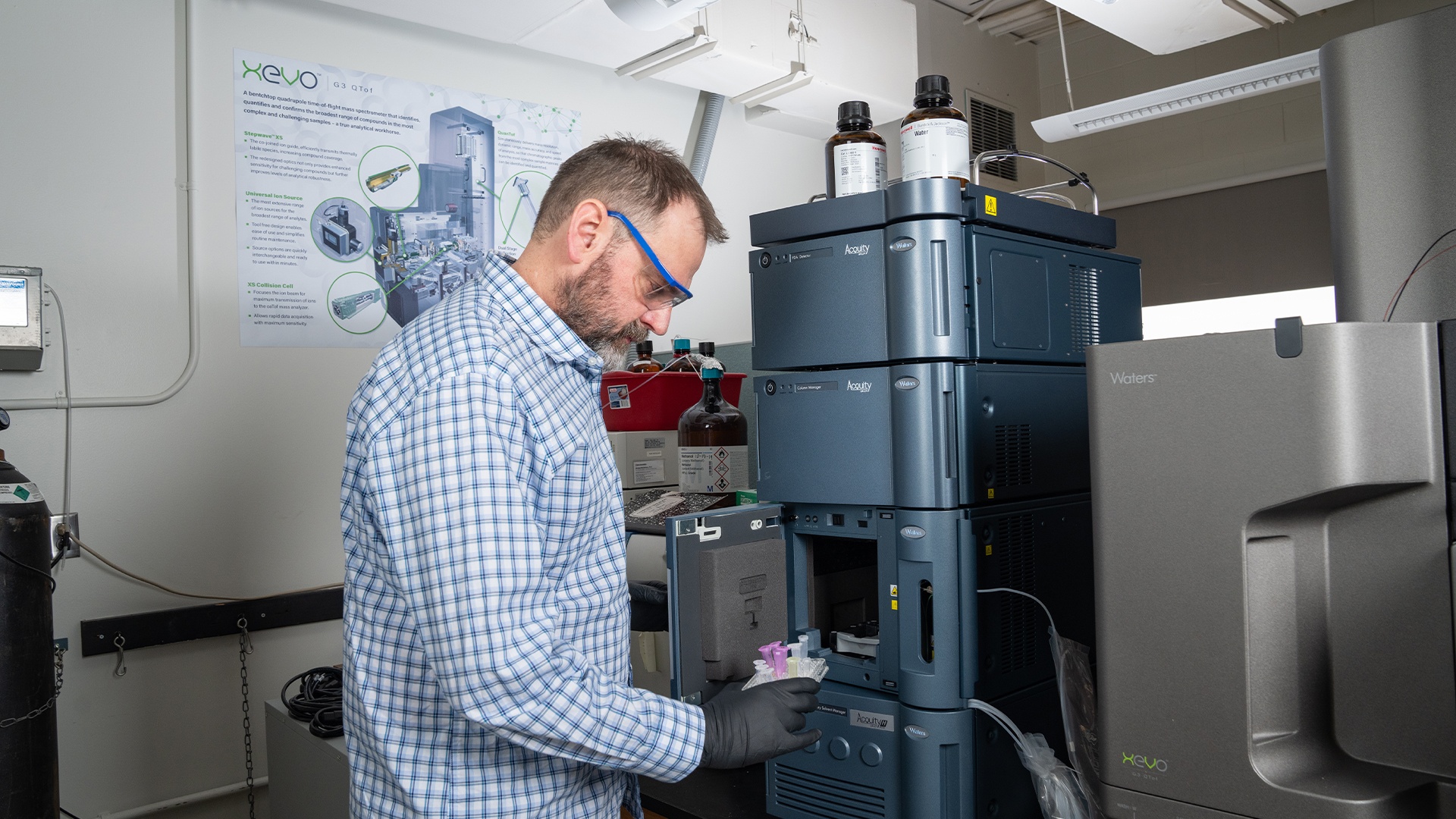
High-resolution mass spectrometer is a ‘game-changer’ for BGSU researchers and students
Estimated Reading Time:
New instrument provides top-of-the-line sample analysis on campus for BGSU scientists
By Nick Piotrowicz
The introduction of a new high-resolution mass spectrometer at Bowling Green State University is already paying massive dividends for BGSU scientists who are dedicated to improving water quality in the Great Lakes region and beyond.
A $482,000 grant from the U.S. Department of Agriculture for a team of BGSU scientists led by Dr. Joe Furgal, an associate professor of photochemical sciences, funded the purchase of the instrument to study agricultural lands and their watersheds, with co-investigators and BGSU faculty Dr. James Metcalf, Dr. Angelica Vazquez-Ortega, Dr. Alexis Ostrowski, Dr. Pavel Anzenbacher, Dr. Christopher Ward and Dr. Kevin McCluney. Many of those faculty members are also part of the Great Lakes and Watershed Studies research group, which conducts interdisciplinary research into environmental and societal issues impacting watersheds while developing solutions and training the next generation of scientists.
The instrument, manufactured by the Waters Corporation, can precisely measure atoms to five decimal places and provide clear data in the span of an hour. Its installation at BGSU is a major difference-maker for University scientists, who are now able to significantly streamline their collection of data and obtain greater accuracy.
Furgal, who studies per and polyfluoroalkyl substances (PFAS) — which are known to be toxic to humans even at low levels and frequently found in water sources — is now able to collect highly accurate data on even tiny amounts of PFAS in water samples and analyze them just a short walk from his laboratory on the University’s campus.
“One of the big issues with a lot of research is that you’re looking for things that are microscopic or in very, very low quantities,” Furgal said. “In order to analyze things in small quantities without this instrument, we have to concentrate everything and hope for the best. That means we’re manipulating the samples quite a bit so we can study them.”
“If you can test the samples directly, and at the concentrations at which they appear in the wild, you can really see how much of each element is there and what their components are without manipulating anything — and that’s what this instrument allows us to do.”

Game-changing research instrument
Metcalf, an associate professor in the BGSU Department of Biological Sciences who recently published ground breaking research about the presence of airborne neurotoxins near the Great Salt Lake, said the new mass spectrometer will be a great aid to BGSU scientists across multiple disciplines.
“This is a game-changer for our analytical capabilities, and it shows the confidence that the USDA has in the research here at BGSU,” Metcalf said. “The fact that we have this instrument here means that research and teaching opportunities will accelerate for graduate students and faculty alike.”
Among the great benefits of having the new mass spectrometer on campus is that researchers — from accomplished faculty members to undergraduates completing their first research projects — can greatly accelerate the process of gathering highly accurate data.
Without a mass spectrometer, scientists went through the tedious process of concentrating samples and/or sending them to an outside lab for analysis, which were often time-consuming and expensive steps.
“You were really looking at months-long turnaround times,” Furgal said. “Now that we have the instrument in-house, you can literally take the sample, run it the day you get it, throw in the sample and have data within an hour.”
Students and faculty benefit
For students in Furgal’s CHEM 4660 or CHEM 5660 classes, for example, use of a mass spectrometer will no longer be theoretical — they will have the chance to actually use the instrument in practice.
BGSU students in multiple scientific disciplines now will be able to learn on, and from, a mass spectrometer, which only improves their understanding of their research and modern science at large, Metcalf said.
“Most students in Ohio likely will not get access to equipment like this,” Metcalf said. “This gives them the ability to get exposed to cutting-edge equipment that’s really incredible, gives them an idea what modern science is really all about and helps them get better employment and better graduate opportunities.”
While field and lab work remains essential to scientific understanding, Metcalf said the use of high-level machinery will only benefit BGSU scientists and the greater public that they seek to inform.
“Obviously, researchers do a lot of fieldwork and a lot of lab work, and this instrument really helps them understand what they’re seeing in their studies at a level not achieved before,” Metcalf said. “Ultimately, what this instrument does is gives faculty the capability to put the icing on the cake of their research.”

Public good water research
As a premier destination for water-quality research in the Great Lakes region, BGSU can continue protecting one of man’s great natural resources through greater scientific understanding.
“We have a lot to protect in Lake Erie, so we can learn the point sources for various contaminants that are entering the lake, how they’re leaching into or above the soil and going into different streams and rivers, which can allow you to then develop mitigation strategies,” Furgal said.
“But you have to know what’s going on before you can take care of it. This instrument helps us understand those complexities.”
Related Stories
Media Contact | Michael Bratton | mbratto@bgsu.edu | 419-372-6349
Updated: 03/06/2024 12:01PM




